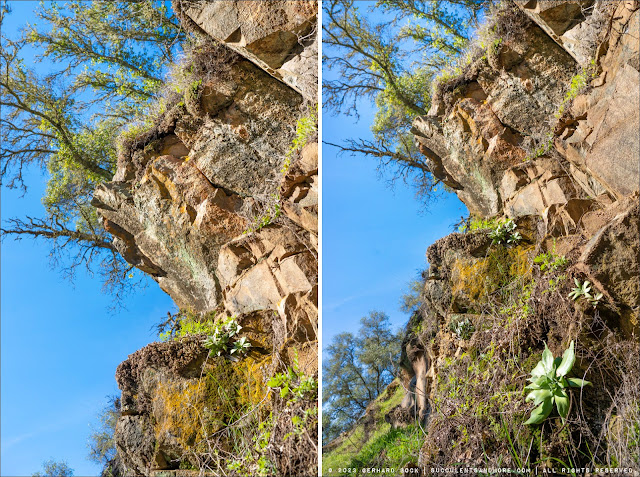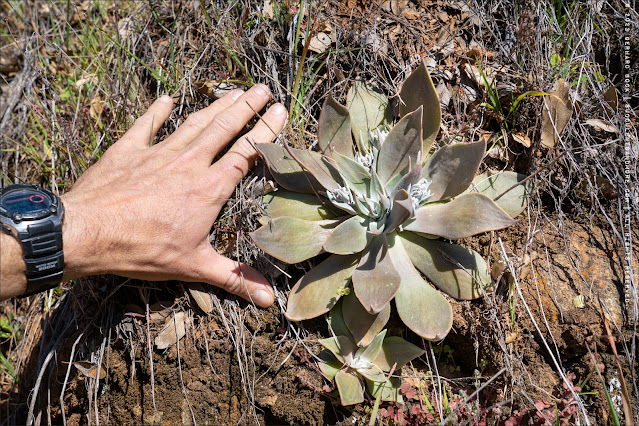Dudleya cymosa in habitat in the Gold Country
Last month my friend Kyle and I went on a field trip to the Gold Country to look at a population of Dudleya cymosa he had discovered earlier. The 50-mile drive from Sacramento takes you from the flats of the Sacramento Valley to the western slope of the Sierra Nevada, essentially from an elevation of 50 ft. to 1200 ft. The Gold Country is rich not only in history—the discovery of gold in 1848 triggered a major migration to California—but also in native flora. For me, as a succulent lover, the most exciting plant is Dudleya cymosa. It’s not exactly rare, not is it particularly beautiful, but it is the our closest native succulent.
Ten years ago, only hardcore plant people knew what dudleyas were. Things are quite different now. National and international media coverage of the large-scale dudleya poaching uncovered in 2018 has raised public awareness of these modest plants and led to groundbreaking legislation to protect them (more info at the bottom of this post). Now dudleyas are the darling of California native plant circles and even casual gardeners know what they are. Wholesale growers have stepped up production of dudleyas and I see them for sale quite regularly at big box garden centers like Lowe’s and Home Depot.
Dudleya cymosa, or canyon liveforever, has a large native range stretching from Southern California to Southern Oregon. It’s the only species found in the inland mountains of Central and Northern California. The rosettes—usually grayish green, often flushing purple in strong sunlight—are 4 to 6 inches wide; some of the plants Kyle and I found were even bigger.
As you can see in these photos, Dudleya cymosa is found on steep hillsides, often in river canyons. The rosettes do virtually all their growing from fall to spring when temperatures are cool and there’s a regular supply of water in the form of rain or even occasional snow. From spring to fall, the only moisture they receive is mist produced by the fast-flowing river if they’re lucky enough to be growing near one. Come spring, Dudleya cymosa produces a brilliant display of orange-red flowers on short stems. I hope to make it back soon to photograph this population in full flower.
 |
| Racemose vs. cymose inflorescence (courtesy of Vedantu.com) |
This is probably more than you ever wanted to know, but there you have it.
As I mentioned earlier, dudleyas (especially Dudleya farinosa) had been a favorite target of organized poachers, with the majority of them ending up in Korea or China. The situation came to a head in 2018 when a dudleya exportation ring was discovered in Northern California. If you want to find out more, I highly recommend a film called Plant Heist by Chelsi de Cuba & Gabriel de Cuba, released in 2021. It’s only 17 minutes, so not a major investment in time. You can watch Plant Heist for free on Vimeo.
In response to the events of 2018, the California Native Plant Society (CPNS) sponsored a bill in the California legislature (AB 223) that provides important new protections for California’s dudleyas, making it unlawful to steal them from state, local, or private lands and sell them. It was signed into law by Governor Newson on September 28, 2021. It’s the first piece of legislation in California to specifically address plant poaching. For more information, read this article on the CPNS website. The Dudleya Protection Act provides stiff fines: a minimum of $5,000 for first offenses, and between $10,000 and $500,000 plus up to 6 months in jail for subsequent offenses.
I don’t know if anybody has been prosecuted yet under this new law, but it’s reassuring to know it exists.












Interesting scenery. Your photos showing the plants in their native habitat makes them seem all the more special to me. I hope the plant poaching law has has an effect - I haven't heard much of anything about this activity since the original articles came out years ago.
ReplyDeleteThank for this info.I’ve known two populations of this plant for a long time. One above Jackson and the other on a steep cut on the road by Clear Lake. I look for them every time I travel by them.
ReplyDeleteIt's amazing how plants manage to survive such steep conditions. We see several hundred year old spruce trees growing out of vertical crevices in the rocks and still only a few feet high. The will to live is great. Great to here that protection is being provided for these wonderful plants. More needs to be done to protect our native flora and fauna.
ReplyDeleteYour article is so interesting as I know next to nothing about these succulents. I learned a lot.
ReplyDeleteThere is an area in Cucamonga Creek that they are growing on the cliffs. I think they are Dudleya pulverulenta, but I am no plant expert so not really sure. It's a short hike up the canyon, you should check them out next time you travel down south.
ReplyDelete